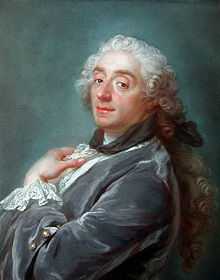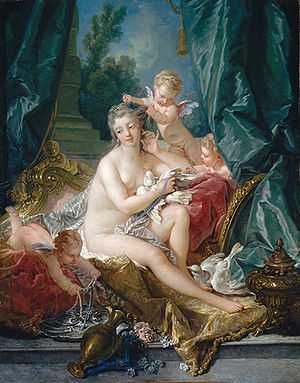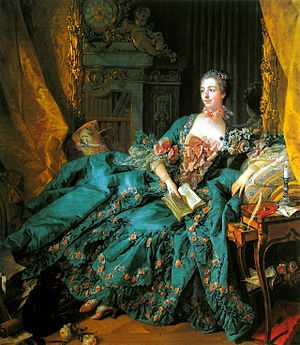François Boucher
| François Boucher | |
|---|---|
 Portrait of François Boucher by Gustaf Lundberg (1741) | |
| Born |
29 September 1703 Paris, Kingdom of France |
| Died |
30 May 1770 (aged 66) Paris, Kingdom of France |
| Nationality |
|
| Known for | Painting |
| Movement | Rococo |
François Boucher (French pronunciation: [fʁɑ̃swa buʃe]) (29 September 1703 – 30 May 1770) was a French painter in the Rococo style. Boucher is known for his idyllic and voluptuous paintings on classical themes, decorative allegories, and pastoral scenes. He was perhaps the most celebrated painter and decorative artist of the 18th century. He also painted several portraits of his patroness, Madame de Pompadour.
Life

.jpg)
A native of Paris, Boucher was the son of a minor painter Nicolas Boucher, who gave him his first artistic training. At the age of seventeen, a painting by Boucher was admired by the painter François Lemoyne. Lemoyne later appointed Boucher as his apprentice, but after only three months, he went to work for the engraver Jean-François Cars.[1] In 1720, he won the elite Grand Prix de Rome for painting, but did not take up the consequential opportunity to study in Italy until five years later, due to financial problems at the Académie royale de peinture et de sculpture.[1] On his return from studying in Italy he was admitted to the refounded Académie de peinture et de sculpture on 24 November 1731.[2] His morceau du reception (reception piece) was his Rinaldo and Armida of 1734.[2]
Boucher became a faculty member in 1734 and his career accelerated from this point as he was promoted Professor then Rector of the Academy, becoming head of the Royal Gobelins Manufactory in 1755 and finally Premier Peintre du Roi (First Painter of the King) in 1765.
Boucher died on 30 May 1770 in his native Paris. His name, along with that of his patron Madame de Pompadour, had become synonymous with the French Rococo style, leading the Goncourt brothers to write: "Boucher is one of those men who represent the taste of a century, who express, personify and embody it."
Boucher is famous for saying that nature is "trop verte et mal éclairée" (too green and badly lit).[3]
Boucher was associated with the gemstone engraver Jacques Guay, whom he taught to draw. Later Boucher made a series of drawings of works by Guay which Madame de Pompadour then engraved and distributed as a handsomely bound volume to favored courtiers.[4] The neoclassical painter Jacques-Louis David began his painting instruction under Boucher.
Painting

Reflecting inspiration gained from such artists as Peter Paul Rubens and Antoine Watteau, Boucher's early works celebrate the idyllic and tranquil portrayal of nature and landscape with great elan. However, his art typically forgoes traditional rural innocence to portray scenes with a definitive style of eroticism as his mythological scenes are passionate and intimately amorous rather than traditionally epic. Marquise de Pompadour (mistress of King Louis XV), whose name became synonymous with Rococo art, was a great admirer of his work.
Boucher's paintings such as The Breakfast (1739), a familial scene, show how he was as a master of the genre scene, where he regularly used his own wife and children as models. These intimate family scenes are contrasting to the licentious style seen in his Odalisque portraits.
The dark-haired version of the Odalisque portraits prompted claims by the art critic Denis Diderot that Boucher was "prostituting his own wife", and the Blonde Odalisque was a portrait that illustrated the extramarital relationships of the King. Boucher gained lasting notoriety through such private commissions for wealthy collectors and, after Diderot expressed his disapproval, his reputation came under increasing critical attack during the last years of his career.
Theatrical and tapestry designs
.jpg)
Along with his painting, Boucher also designed theater costumes and sets, and the ardent intrigues of the comic operas of Charles Simon Favart closely paralleled his own style of painting. Tapestry design was also a concern. For the Beauvais tapestry workshops he first designed a series of Fêtes italiennes ("Italian festivals") in 1736, which proved to be very successful and often rewoven over the years, and then, commissioned in 1737, a suite of the story of Cupid and Psyche.[5] During two decades' involvement with the Beauvais tapestry workshops Boucher produced designs for six series of hangings in all, like the tapestry showing Psyche and the Basketmaker from 1741–1742. Only his appointment in 1755 as director of the rival Gobelins tapestry terminated the association.
Boucher was also called upon for designs for court festivities organized by that section of the King's household called the Menus-Plaisirs du Roi and for the opera and for royal châteaux Versailles, Fontainebleau and Choisy. His designs for all of the aforementioned augmented his earlier reputation, resulting in many engravings from his work and even reproduction of his designs on porcelain and biscuit-ware at the Vincennes and Sèvres factories.
Gallery
-

Self-portrait in the Studio, 1720, Louvre
-

Putti with Birds, c. 1730-1733, Honolulu Museum of Art
-

Rinaldo and Armida, 1734
-

Diana Leaving the Bath 1742
-

Venus Consoling Love 1751
-

The Toilet of Venus (1751) typifies the pleasing elegance of Boucher's mature style.
-

The Bridge, 1751, Louvre
-

Saint Peter Attempting to Walk on Water, 1766, Cathédrale Saint-Louis, Versailles
-

Dreaming Shepherdess
-

Autumn Pastoral
-

Vulcan Presenting Venus with Arms for Aeneas
See also
| Wikimedia Commons has media related to François Boucher. |
References
- ↑ 1.0 1.1 "François Boucher", Oxford Art Online
- ↑ 2.0 2.1 Levey, Michael. (1993) Painting and sculpture in France 1700-1789. New Haven: Yale University Press, p. 164. ISBN 0300064942
- ↑ Houssaye, Arsène (1843). "Boucher et la peinture sous Louis XV". Revue des deux mondes. n. s. 3: 70–98. p. 86 (citing a letter to Nicolas Lancret).
- ↑ Leturcq, Jean François (1873). Notice sur Jacques Guay, graveur sur pierres fines du roi Louis xv. Documents émanant de Guay, et notes sur les œuvres de gravure en taille-douce et en pierres fines de la marquise de Pompadour. pp. 10–12. Retrieved 2014-08-24.
- ↑ Kathryn B. Hiesinger, "The Sources of François Boucher's 'Psyche' Tapestries" Philadelphia Museum of Art Bulletin 72 No. 314 (November 1976), pp. 7-23.
External links
 | |
|
| |
|
|
- francoisboucher.org
- Prints & People: A Social History of Printed Pictures, an exhibition catalog from The Metropolitan Museum of Art (fully available online as PDF), which contains material on Boucher (see index)
|
